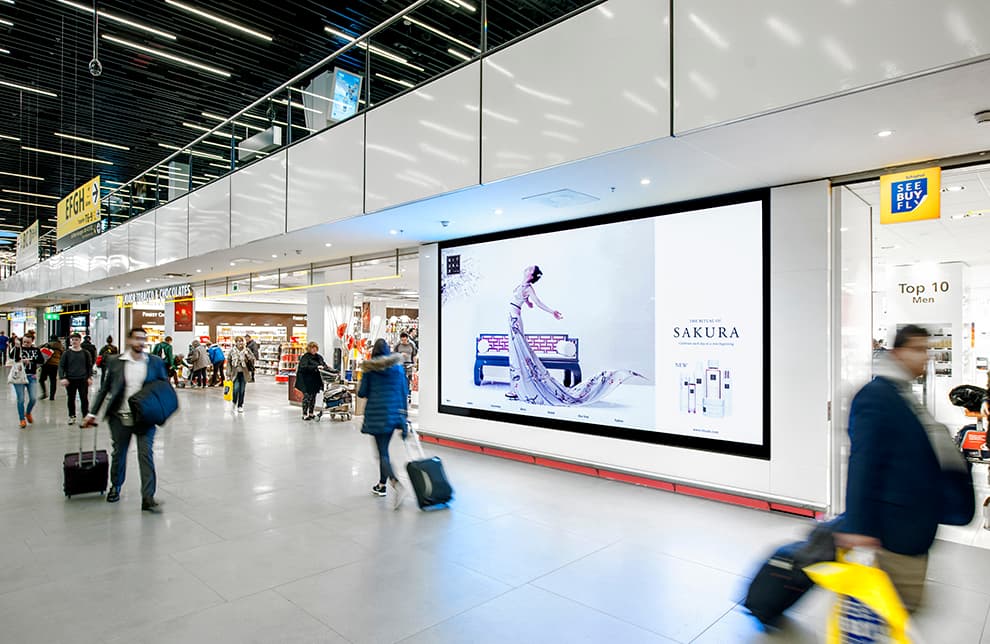Programmatic Digital Out-of-Home:: How do you get it going?
Traditional advertising channels – like television, radio and Out-of-Home – are mainly used today as mass media. Advertisers reach a huge audience and don’t exclude anyone. But in the coming years, that will all change thanks to programmatic. This new way to purchase media allows you to present the most relevant message to the most relevant customer at the most relevant moment. The ultimate tool for brands, media planners and advertising agencies? In a lot of ways, it is. But don’t follow this new trend blindly. First, think about how to make programmatic work for your particular brand.

To learn more about the power of DOOH, Timo Beuzekom from Schiphol Media spoke with experts Tobias van Amstel from Signkick, Michael van Kloosterhuis from Traffic Builders digital marketing and Wendy Pouw from industry association IAB Nederland.
Back to the drawing board
If you already use Digital Out-of-Home (DOOH) extensively, then programmatic has the potential to become an important part of your media mix. In order to optimally use the strengths of this advertising form, it’s important to create policies within your organisation. How do you want to deploy programmatic? Which screens and/or networks are interesting to you? In what moments are opportunities available to reach your target audience? And which external factors offer starting points to reinforce your message?
Find the right balance between mass media, eCommerce and programmatic in your media mix. And set up your organisation in a way that enables quick decision-making. In theory, a programmatic campaign can be live within an hour. All over the country, if you want it to be. But that requires guts, and an organisation that makes very swift decisions about advertisements. Make sure there are short lines of communication between creatives and those who make financial and commercial decisions.
Will radio, television and Out-of-Home soon become extensions of online, which should primarily generate money through conversion? Perhaps. And if from now on, you only used programmatic campaigns, you might initially see highly desired (sales) results. In the longer term, however, this approach can come at the expense of the emotional bond that consumers have with your brand, service or product. So it’s unwise to put all your eggs in the conversion basket. You need space to tell stories and to inspire. That is why we use the REAN-model to determine how and when you can best use certain channels.
Michael Kloosterhuis, Display Advertising Consultant at Traffic Builders
Increase relevance? Keep it simple
With programmatic, you can tweak everything. But therein also lies the danger. Purchasing can be accurate to the minute, and there are an infinite number of variables to add. But beware: if you don’t impose enough limits on yourself, a complex programmatic puzzle will arise before you know it. Do you want to use personal information? Then you run the risk of getting caught in a web of privacy rules. That can slow down your processes considerably. Fortunately, you don’t need much data at all to be relevant. You can already come up with all kinds of variations to an advert based on weather forecasts, traffic data, times or locations, for example. All without getting the privacy watchdogs on your case.
Dos
- Think long and hard about the best way to use DOOH programmatic. You have a chance to pleasantly surprise consumers with a creative, relevant and personal advert. Make the most of it.
- Determine programmatic’s place in your overall media mix, and set that in your strategy. You can also still use (D)OOH objects as mass media.
- Ensure plenty of repetition for your target audience. Better a big fish in a small pond than using the same budget to be a small fish in a big one.
- Make your logo at least 25% of the entire advert.
Dont’s
- Don’t opt for static images on DOOH if you can use moving images. Full motion has more impact than simple pictures.
- Don’t simply transfer print or TV campaigns to DOOH. Programmatic DOOH is a discipline in itself. Approach it that way, and create specific content for it.
- Don’t try to say too much in those few seconds. Less is definitely more.
Read more
-
DOOH: a landslide in the advert landscape?
How can you capture the power of Digital Out-of-Home (DOOH)?

-
Programmatic DOOH: what you can (and can’t) do
Think about how to make it work for your particular brand
